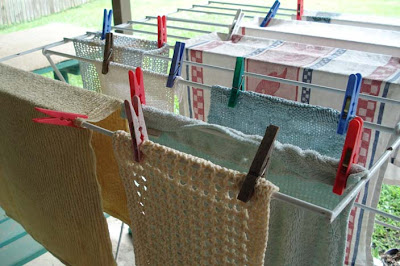Line drying your laundry is remarkably efficient. All you need is the time and a bit of effort to do it - sun and breeze are supplied free to all with the will to use them. You'll need a clothes line, and that can be rope or wire, and pegs. If there is no wind, you could even do without the pegs and just place the clothes neatly over the line - or a fence or large bush. In the old days many women used lavender bushes to dry their clothes.
Start your task by shaking the item before hanging it. That will take out obvious folds and some of the creases. If you can hang your pillow slips, tea towels, T shirts, aprons, napkins etc. well, so that they hang straight without creases, you won't have to iron them. The more creases and folds you remove at the hanging stage, the more work you save yourself later. Even most jeans and some shirts can be hung like this so you won't have to iron them. Shaking is essential.
If you have a rotary line, start with your underwear and the smaller items in the middle and work out to your larger sheets and towels. If you have a long line, hang the smaller items in the middle and the heavier things on the ends of the line. If you have a lot of shirts it might we worth your while to shake them, hang them on plastic clothes hangers then attach the hanger to the line for drying. This might cut down on your ironing as well. If you live in a wet or humid climate, it is better to use plastic pegs as the wooden ones will develop mould over time, and a mouldy peg on wet fabric could stain your clothes.
When the clothes are dry and full of the smell of sunshine, unpeg them, place them in your basket, take them inside straight away and fold them. I do this on the kitchen table as it gives me enough room to work and stack the clothes. It's also a central place from where I can easily put away tea towels, napkins, dishclothes, towels and sheets as soon as they're folded and stacked. Never put off your folding because if you do you'll have creased clothes that will have to be ironed. I have been able to cut my ironing by fifty percent by shaking wet clothes at the line, careful hanging and folding as soon as the clothes are off the line.
Hanging laundry is a wonderful thing to do. You might think of it as yet another chore but it allows you to take advantage of the outdoors, the fresh air and sunshine. You are using the natural elements of your surrounding environment to help keep your clothes clean. It's one of those things we can do that doesn't rely on electricity - it's just you and the pegs.
If you haven't tried line drying yet, give it a go. Your clothes and household linens will last longer as they aren't subject to the heat and constant tumbling action of a dryer. Yes, it does take more effort on your part to do it, but these gentle exercises are good for all of us. Hanging laundry is one of those little things that gives you the chance slow down and to be mindful of the many simple things you can do at home.
I had a load of moist hand towels from the Centre that needed to be washed straight away. These dried well yesterday under the cover of the back verandah roof.
TOP REASONS TO HANG OUT YOUR CLOTHES from this site.
Electric dryers use five to ten percent of residential electricity in the United States!
Save money (more than $100/year on electric bill for most households).
Conserve energy and the environment.
Clothes and sheets smell better.
Clothes last longer. Where do you think lint comes from?
It is physical activity which you can do in or outside.
Sunlight bleaches and disinfects
Indoor racks can humidify in dry winter weather
Clothes dryer fires account for about 15,600 structure fires, 15 deaths, and 400 injuries annually. The yearly national fire loss for clothes dryer fires in structures is estimated at $99 million.
MORE READING
Washing and drying clothes - Australia
Hanging Items Upon a Clothesline - UK
How to dry your clothes outside - USA


